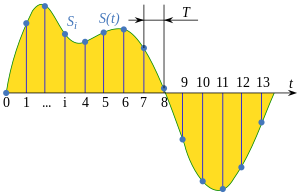
Back استعيان Arabic Дискретизация (обработка на сигнали) Bulgarian Mostratge digital Catalan Vzorkování Czech Sampling (signalbehandling) Danish Abtastung (Signalverarbeitung) German Δειγματοληψία σήματος Greek Specimenado Esperanto Muestreo (señal) Spanish Diskreetimine Estonian

In signal processing, sampling is the reduction of a continuous-time signal to a discrete-time signal. A common example is the conversion of a sound wave to a sequence of "samples". A sample is a value of the signal at a point in time and/or space; this definition differs from the term's usage in statistics, which refers to a set of such values.[A]
A sampler is a subsystem or operation that extracts samples from a continuous signal. A theoretical ideal sampler produces samples equivalent to the instantaneous value of the continuous signal at the desired points.
The original signal can be reconstructed from a sequence of samples, up to the Nyquist limit, by passing the sequence of samples through a reconstruction filter.
Cite error: There are <ref group=upper-alpha> tags or {{efn-ua}} templates on this page, but the references will not show without a {{reflist|group=upper-alpha}} template or {{notelist-ua}} template (see the help page).